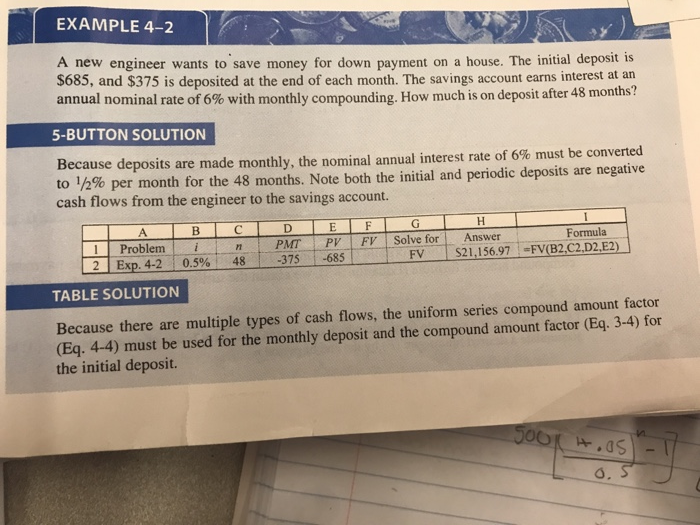please show me the fomula and the reasoning

EXAMPLE 4-2 A new engineer wants to save money for down payment on a house. The initial deposit is $085, and $375 is deposited at the end of each month. The savings account earns interest at an annual nominal rate of 6% with monthly compounding. How much is on deposit after 48 months! 5-BUTTON SOLUTION Because deposits are made monthly, the nominal annual interest rate of 6% must be converted to '/2% per month for the 48 months. Note both the initial and periodic deposits are negative cash flows from the engineer to the savings account. ATBTCTD E F G H I 1 Problem PMT PV FV Solve for Answer Formula 2 Exp. 4-2 0.5% 48 -375 -685 FV S21.156.97 = V(B2,C2,D2.E2) TABLE SOLUTION Because there are multiple types of cash flows, the uniform series compound amount factor (Eq. 4-4) must be used for the monthly deposit and the compound amount factor (Eq. 3-4) for the initial deposit. JOOK .05 0.5 Uniform Series Compound Interest Formulas The horizontal line in Figure 4-1 is a ver of time with four interest penoas illustrated. Uniform payments A have been placed the end of each interest period, and there are as many A's as there are interest periods (Both these conditions are specified in the definition of A.) Figure 4-1 uses January 1 and December 31. but other 1-year or othe length periods could be used. In Chapter 3's section on single payment formulas, we saw that a sum P at one point in time would increase to a sum Finn periods, according to the equation F = P(1 + i)" We will use this relationship in our uniform series derivation. Looking at Figure 4-1, we see that if an amount A is invested at the end of each year for 4 years, the total amount F at the end of 4 years will be the sum of the compound amounts of the individual investments. Fy 14 A A A A 0- 1- 2- 3- 4- 0- 1- 2- 0 4+ 3- 3 - 4+ 1- 2 4 3- +0- 4 1- 2- ACI + 1) + All+ i) + A1+1) A + 0-1-2-3-4 In the general case for n years, (4-1) F = A(1 + 1)-1 + ... +A(1 + 1) +A(1 +12 +A(1 + i) + A Multiplying Equation 4-1 by (1 + i), we have (1 + 1F = A(1+1)" + ... +A(1+1 + A(1 + i) +A(1 + 1)2 +A(1 + i) (4-27 Factoring out A and subtracting Equation 4-1 gives (1 + i)F=A[(1 + )"+.+ (1+1)* + (1+1 +(1+12+(1+1 F=A[i+1)n-1 + (1+1+1+1+(1+) + 1] iF=A[(1 +1" - 1] (4-3)









